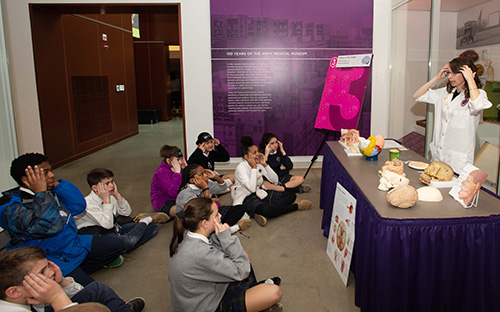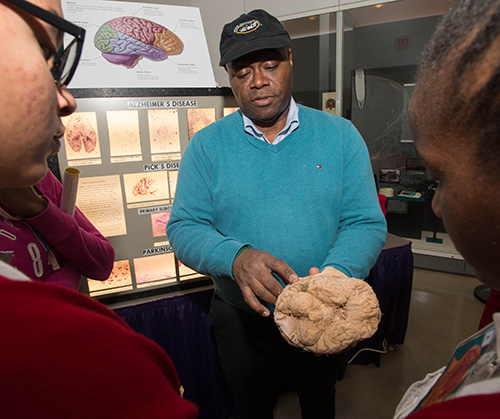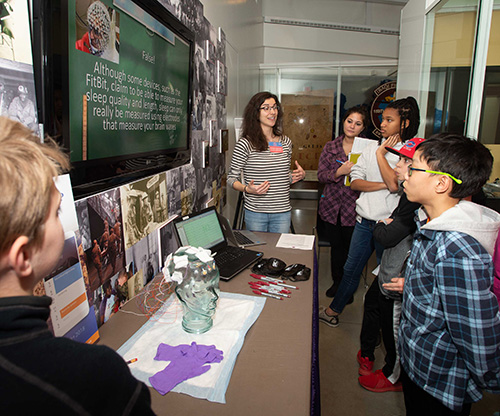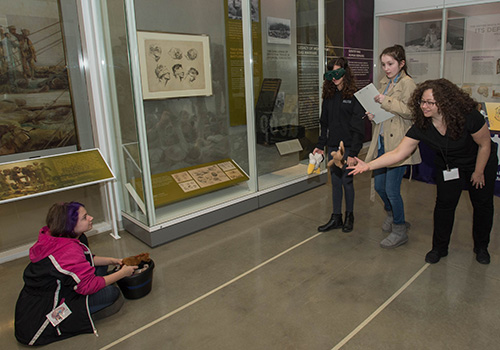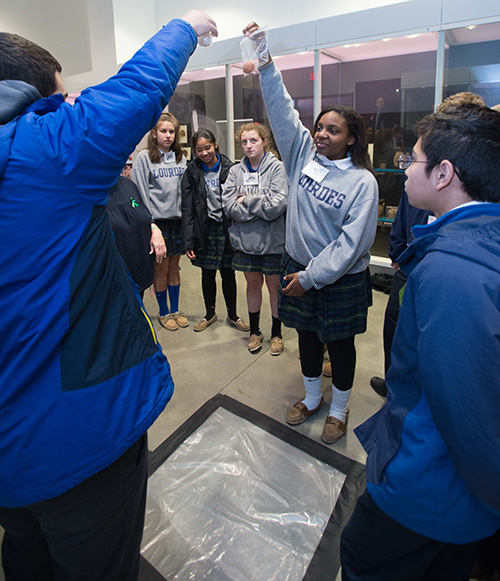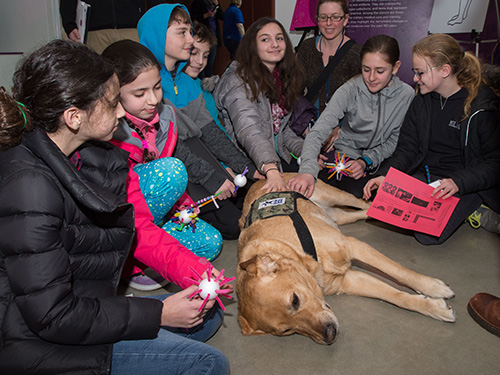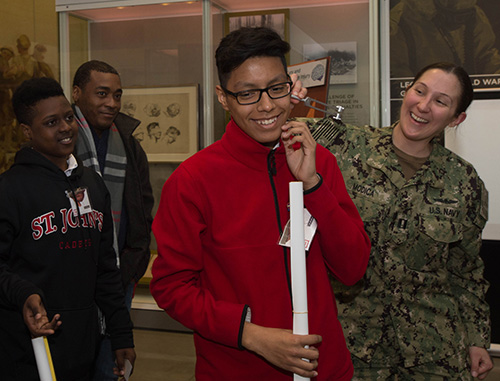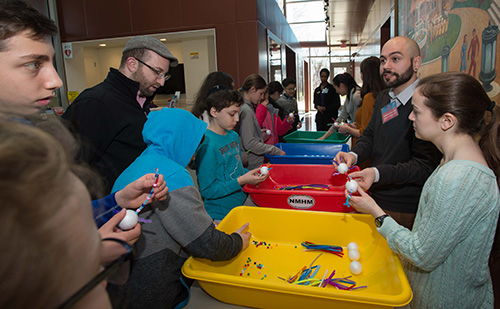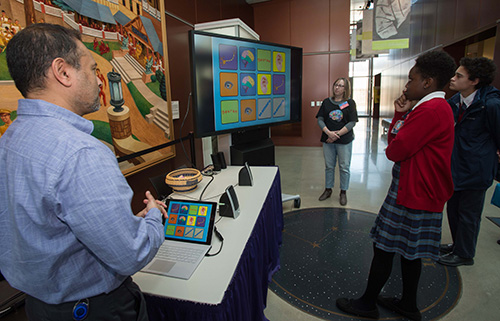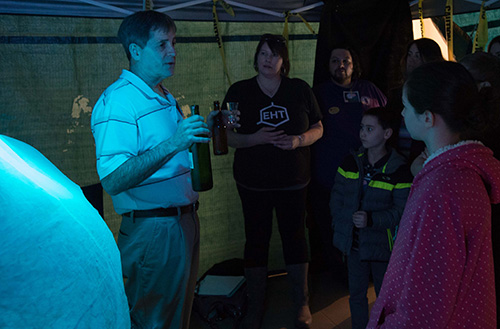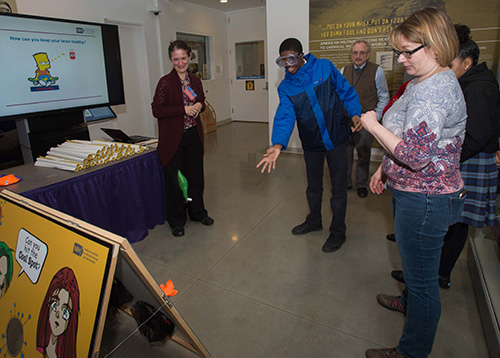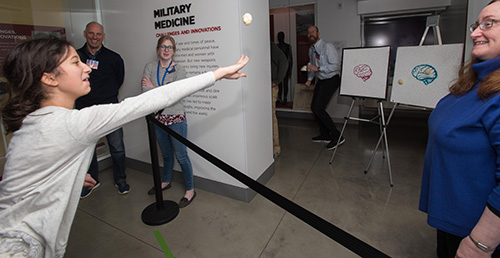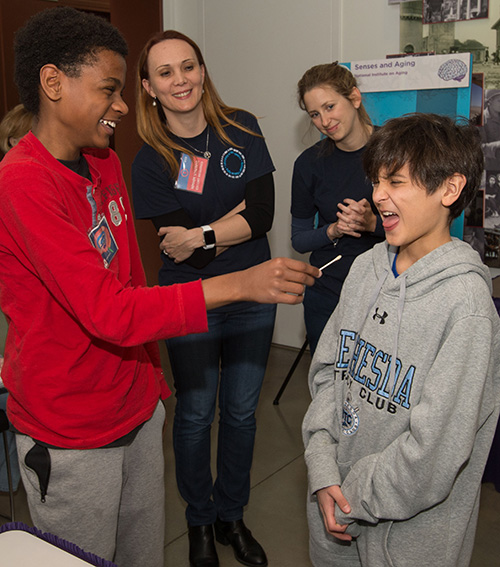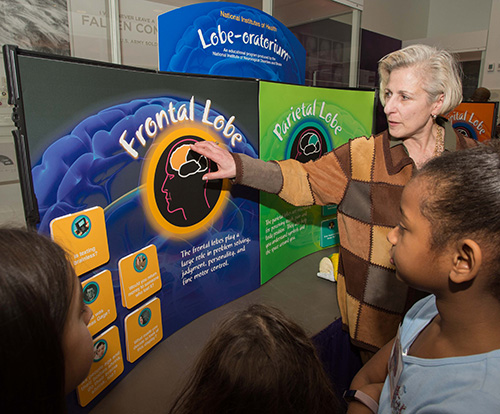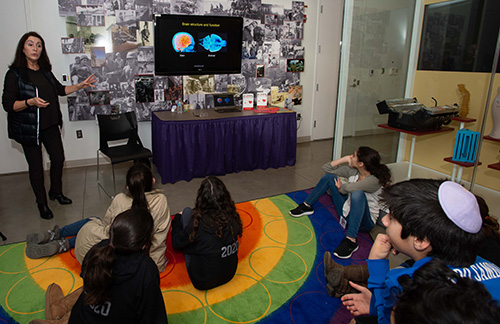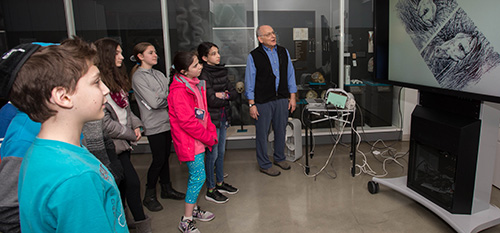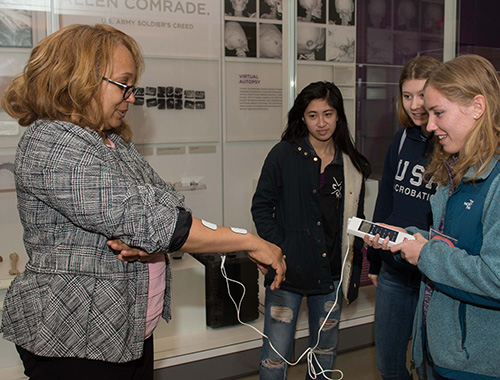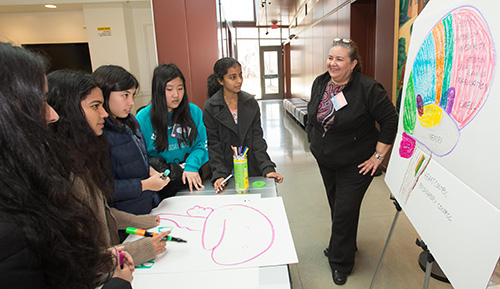Neuroscience and Military Medicine Spotlighted During 2018 Brain Awareness Week at National Musuem of Health and Medicine
By Lauren Bigge
NMHM Public Affairs Coordinator
Inspiring an interest in the brain sciences was the objective of Brain Awareness Week at the National Museum of Health and Medicine (NMHM), a Department of Defense (DoD) museum in Silver Spring, Md., from March 13-16, 2018. March is recognized as Traumatic Brain Injury Awareness Month by the DoD each year.
BAW, now in its 19th year at NMHM, is an annual event bringing together middle-school students with the museum's education partners, including subject matter experts from government agencies and military medical research agencies. BAW was founded by the Dana Alliance for Brain Initiatives, an organization dedicated to advancing brain research.
The students discovered how important brain research is at several stations during the week.
Kristen Pearlstein, Ph.D., anatomical collections manager for NMHM, used models from the museum's collections for a cranial nerve demonstration to illustrate that brain-focused research helps medical professionals understand the complexities of connections in the human body. She showed the students how nerve signals travel from the brain to target areas. "The nerves are bundles of fibers, like the cables of our bodies," she explained. They learned the parts that the nine nerve bundles play in everyday living, and the effects of nerve damage.
Archibald Fobbs, NMHM's neuroanatomical collections manager, talked to the students about how the brain works and why it's so important to take good care of it. "We're sharing how this museum's collection has the potential to support all manner of research about the brain and encouraging the students to consider careers in the brain sciences," he said. Fobbs encouraged students at his station to hold a real human brain.
Presenters from the Walter Reed Army Institute of Research's Sleep Research Center divided students into teams for a True/False game to explain the importance of sleep to service members. Students saw what brain waves look like on a screen when a sleeping test subject's brain waves are monitored with an EEG electrode set-up.
Students visited the Walter Reed Army Institute of Research's "Exploring Neuroplasticity" table to learn about the brain's ability to adapt to changes in incoming sensory information. Emily Kuehn, Ph.D., explained that the children were being introduced to the concept of neuroplasticity, the process by which brain cells make connections with each other.
Teaching students about military medicine in the context of the wounds of war was the theme at several stations.
Students visiting the Defense and Veterans Brain Injury Center's (DVBIC) station got to drop eggs on the floor – one encased in bubble wrap, one not – to learn about protecting themselves from brain injuries. The egg simulates your brain, explained Heather Kopf, MPH, education network coordinator for DVBIC.
"If for some reason you were hit in the head, seek care – get checked out," she said. "In this activity, we talk about how brain injuries are invisible wounds of war, especially within the military. The [intent] for the Egg Drop activity is to talk about why it's important to wear your helmet. It can help prevent the more severe brain injuries." She also noted that there are three types of concussions experienced by service members: mild, moderate, and severe; approximately 82 percent of concussions occur outside of combat zones.
The Warrior Canine Connection's Dr. Robert Koffman, chief medical advisor as well as a retired Navy psychiatrist, encouraged students to pet Ron the therapy canine as he explained that service members returning home "with hidden wounds of war can do amazing things, like train a dog." Ron has been in training for two years, and now will serve the specific needs of an owner. "Ron is a nice demonstration of the calming and bonding effects of oxytocin, which is a central part of the human-animal bond."
Naval Medical Research Center personnel taught the students about blast injury and traumatic brain injury; they wanted the students to gain an understanding of blast exposure and that a shock wave is a wave of energy that travels through the air. Lt. Claire Modica struck a tuning fork against a table, then placed it on the bone right behind the ears of volunteers to simulate "a ringing in the ear." The tuning fork was then placed in a cup of water, where its vibration created a small wave. The message: blast injuries present a large hearing loss threat.
At the Uniformed Services University of the Health Sciences' table, students made their own "neurons" while learning about the parts of a neuron. "We discussed the special properties of the neuron, and what makes it special as a cell and as a unit of the brain," said Michael Nieves, a neuroscience graduate program student.
Alcohol, stress and disease processes can impact memory, Naba Bora, program manager, explained at the Department of Defense's Congressionally Directed Medical Research Program table. The team used a video to teach the students the basics of short-term and long-term memory, especially in the context of studying. "Challenging your brain can increase its size," said Bora. An on-screen game helped them to demonstrate to the students the process of forming memories.
Numerous agencies from the National Institutes of Health participated in this year's BAW programming. Dennis Twombly, Ph.D., from the Eunice Kennedy Shriver National Institute of Child Health and Human Development and his "Drunken Brain" tent demonstrated how alcohol impacts various areas of the brain. Personnel from the National Institute on Alcohol Abuse and Alcoholism shared how alcohol interferes with adolescent brain development. The National Institute on Drug Abuse offered a game to teach about different structures of the brain and the effects of different drugs on the brain. The National Institute on Aging shared how different senses, such as taste and smell, vary and develop as a person ages. The National Institute of Neurological Disorders and Stroke "Lobe-oratorium" station gave students the chance to learn about all four lobes of the human brain. The National Institute on Mental Health shared demonstrations related to perception.
Kristina Beaugh, public affairs specialist, and her colleagues from the National Eye Institute showed the students that "the brain and the eyes work together. We live in a 3-D world, but when we see an optical illusion it can trick our brain. We are talking about eye anatomy and different diseases disrupting our vision."
Rutgers, The State University of New Jersey's "Seeing is Believing (Or is it?)" station had a similar theme. Barry Komisaruk, Ph.D., department of psychology, presented both stroboscopic effects and optical illusions, pointing out the importance of context. "We have an ambiguous set of information, but when we have a concept of what it is, we see it and fill in the blanks," he said. "If we believe in something, we can see it. This is the kind of thing that happens in science all the time. It's the interaction of what's coming into our brain, and how our brain puts it together. " Komisaruk was joined by his colleague Dr. Ma Cruz R. del Cerro, a professor from Universidad Nacional de Educación a Distancia's Department of Psychobiology in Madrid, who said the goal for her "Parental Love Stimulates Brain Development" station was for the students to understand that the feelings of love and affection are crucial for development of the brain during the first six years of life.
And Howard University facilitated two different stations: the first was offered by the physical therapy department at Howard University's College of Nursing and Allied Health Sciences and showed students how the brain controls the body and interprets environmental information; the second, from the university's College of Medicine, focused on the functions and connectivity of different areas of the brain during activity, like which parts of the brain are necessary when ice skating.
BAW at NMHM supports the Department of Defense's science, technology, engineering and math –STEM – development priorities. The BAW program is closely aligned with performance expectations for middle school students as described in the Next Generation Science Standards promoted by the National Academy of Sciences.
